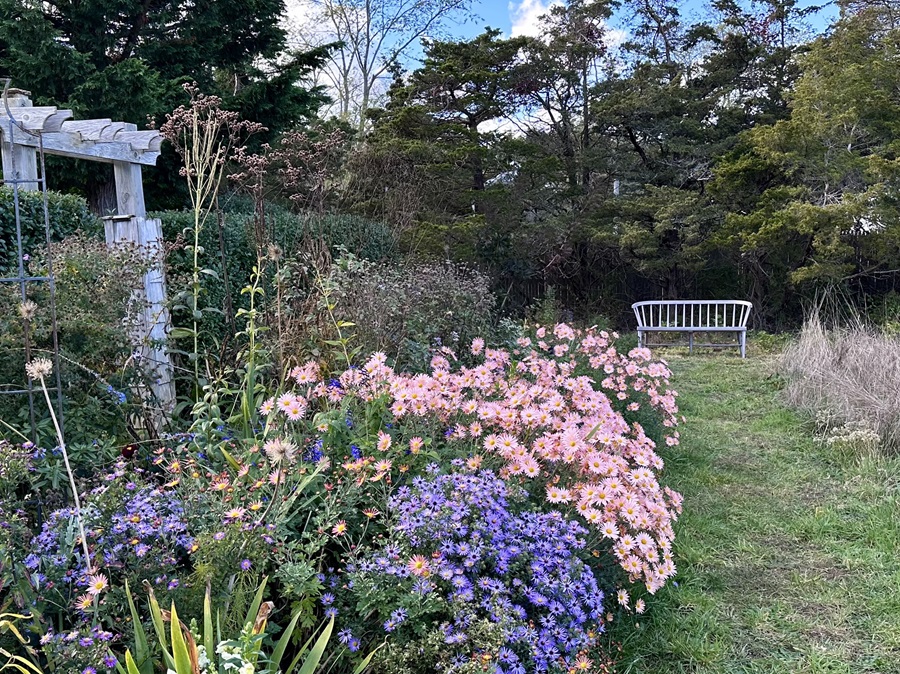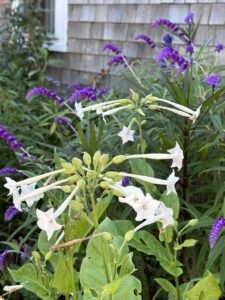In contrast to its slow, gray springs, the Outer Cape is famous for its benevolent autumns. Just as the earliest crocuses and daffodils give me hope during what one friend calls the January, February, March, March, March doldrums, I aim to extend the end of the fall growing season by adding new late-blooming varieties each year — the later the better to put off the advent of winter.

I love chrysanthemums, and in my garden I focus on the hardy or perennial mum varieties that mix gracefully into a flower border instead of being restricted to a container. Barbie pink ‘Clara Curtis’ pops first for me, but she is not as robust as some of the others like ‘Sheffield,’ which grows into a three-foot bush covered with pale peach flowers starting in mid-October. I’ve been collecting others, too: darker mauve ‘Cambodian Queen,’ deep orange ‘Tangerine Spoon,’ and magenta ‘High Style’ among them. When I can’t find one I want locally, Bluestone Perennials has a large online selection.

My asters, also members of the Compositae clan, have taken off in this their third year and are currently buzzing with pollinators. I love mixing all the purple, magenta, and blue varieties so that the colors vibrate against each other. Some, like the native smooth aster (Symphyotrichum leave), are airy and weave in and out of the other plants in a graceful way. Others, such as Aster × frikartii ‘Mönch,’ form a solid mass of deep violet flowers. Like my mums, I can’t seem to have too many of them.

Other late-blooming perennials include royal purple Lobelia ‘Starship Blue,’ which echoes all the aster shades nicely. Tall spires of monkshood, a favorite of poisoners in the imperial Roman court, act as an autumnal doppelganger for delphinium in my front border. It truly is toxic, even to the touch, so wear gloves if you’re handling it, but the eerie, deeply indigo flowerheads that resemble hooded monks are worth the danger to me.

White and pink Japanese anemones fill out the borders with springy-looking flowers that bob around, taking the ever-growing winds from the back shore in stride. Breezy plants like gaura continue to self-sow, creating airy clouds of white and pink butterflies next to a glaucous lavender cultivar of little bluestem called ‘Standing Ovation.’ Tall sedums hang onto their sturdy, flat-topped blossoms for weeks if not months. I have two anise hyssop plants, one that has petered out and another that continues to form long bottlebrush flower stems. Like the gaura, it has been going strong since June.

My dahlias have been off this year; maybe I didn’t water them enough during the summer drought. But they have finally started to produce flowers in earnest, as if skidding into home base in these final weeks before the first frost. I focused on dark varieties this year like ‘Nighty Night,’ ‘Lights Out,’ and the bicolored ‘Tartan.’ Many of them were victimized by chomping earwigs, so next year I will try the earwig traps I’ve seen posted on social media — small terra cotta pots filled with straw that you perch on tall poles.
Annuals and tender perennials keep thriving, some of which seem almost too delicate to survive the colder nights. Alyssum, a maritime plant, has bounced back from its midsummer sulk and fills in many nooks and crannies of the garden. I grow it two ways: direct-sown seed tends to make loose patches of airy flowers, while plants bought in six-packs tend to stay as tidy cushions. I like both. And I love its musk-honey fragrance as I pass by.

Speaking of scents, my chocolate cosmos (Cosmos atrosanguineus) still smells like hot cocoa when the sun hits it on warm days. And if the evening is warmish, my tall woodland tobacco (Nicotiana sylvestris) gives off a jasmine perfume. It’s cousin Nicotiana langsdorffii doesn’t have a fragrance but remains covered in chartreuse bells until felled by the frost. I always add a few tall shrubby salvias like electric blue Salvia guaranitica, sky blue S. uliginosa, fuzzy purple S. leucantha, and purple and white S. ‘Waverly.’ I buy them as small potted plants in June, and by September each one can be five feet tall and covered with dozens of flowers that are beloved by hummingbirds and pollinating insects of all types. Many of these warm climate plants are tougher than you might imagine.

I find great pleasure in discovering things still blooming deep in the flower beds as I begin to plant bulbs in October and November. A tall white snapdragon that has survived two winters as a plant (not reseeded) proves that sometimes the distinction between annual and perennial is not exact. My growing collection of autumn crocuses and colchicums emerges, looking unexpectedly springy as if they’d arrived overdressed for the wrong party just as everyone is leaving. Seedheads of alliums, especially the super-tall ‘Summer Drummer’ and the whorled tiers of dried Jerusalem sage seedheads (Phlomis fruticosa), always draw a “what is that?” from visitors. I also like to leave most of my perennials up well into the winter as a food and shelter source for wildlife.

Thinking of my garden as a musical score, I will always strive for it to end with a crescendo to fortissississimo instead of a prolonged, quiet sostenuto. After all, there’s enough time to enjoy that sort of quiet during our long winters and the subsequent slow walk to spring that follows. For now, carpe autumnus!



